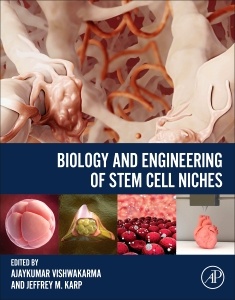Description
Biology and Engineering of Stem Cell Niches
Coordinators: Vishwakarma Ajaykumar, Karp Jeffrey M
Language: English
Subjects for Biology and Engineering of Stem Cell Niches:
642 p. · 21.4x27.6 cm · Paperback
Description
/li>Contents
/li>Biography
/li>Comment
/li>
Biology and Engineering of Stem Cell Niches covers a wide spectrum of research and current knowledge on embryonic and adult stem cell niches, focusing on the understanding of stem cell niche molecules and signaling mechanisms, including cell-cell/cell-matrix interactions.
The book comprehensively reviews factors regulating stem cell behavior and the corresponding approaches for understanding the subsequent effect of providing the proper matrix molecules, mechanical cues, and/or chemical cues. It encompasses a variety of tools and techniques for developing biomaterials-based methods to model synthetic stem cell niches in vivo, or to enhance and direct stem cell fate in vitro.
A final section of the book discusses stem cell niche bioengineering strategies and current advances in each tissue type.
Part I. Biology of Stem Cell Niches and Molecular Mechanisms 1. The Need to Study, Mimic, and Target Stem Cell Niches 2. Harnessing the Biology of Stem Cells' Niche 3. Pluripotent Stem Cell Microenvironment 4. Regulation of Hematopoietic Stem Cell Dynamics by Molecular Niche Signaling 5. HSC Niche: Regulation of Mobilization and Homing 6. Neuronal Stem Cell Niches of the Brain 7. Cardiovascular Stem Cell Niche 8. Intestinal Epithelial Lgr5+ Stem Cell Niche and Organoids 9. The Epithelial Stem Cell Niche in Skin 10. The Satellite Cell Niche in Skeletal Muscle 11. The Cancer Stem Cell Niche 12. Cellular Senescence and Stem Cell Niche
Part II. Biochemical and Physical Cues in The Stem Cell Niche Directing Cell Fate 13. Matrix Chemistry Controlling Stem Cell Behavior 14. Matrix Growth Factor and Surface Ligand Presentation 15. Effect of Matrix Mechanical Forces and Geometry on Stem Cell Behavior 16. Wettability Effect on Stem Cell Behavior 17. Fluid Flow Control of Stem Cells With Investigation of Mechanotransduction Pathways 18. Hypoxia Regulation of Stem Cell: Mechanisms, Biological Properties, and Applications
Part III. Designing Smart Biomaterials to Mimic and Control Stem Cell Niche 19. Polymer Design and Development 20. Design and Development of Ceramics and Glasses 21. Surface Functionalization of Biomaterials 22. Biofunctional Hydrogels for Three-Dimensional Stem Cell Culture 23. Technologies to Engineer Cell Substrate Mechanics in Hydrogels 24. Micro- and Nanosurface Patterning Technologies 25. Self-Assembled Nanostructures (SANs) 26. Biomimetic Nanofibers as Artificial Stem Cell Niche
Part IV. Bioengineering Strategies to Model Synthetic Stem Cell Niches 27. Employing Microfluidic Devices to Induce Concentration Gradients 28. Engineering Niches for Embryonic and Induced Pluripotent Stem Cells 29. Engineering Niches for Cardiovascular Tissue Regeneration 30. Engineering Niches for Blood Vessel Regeneration 31. Engineering Niches for Bone Tissue Regeneration 32. Engineering Vascular Niche for Bone Tissue Regeneration 33. Engineering Niches for Cartilage Tissue Regeneration 34. Engineering Niches for Stem and Progenitor Cell Differentiation Into Immune Cells 35. Engineering Niches for Skin and Wound Healing 36. Designing Stem Cell Niche for Liver Development and Regeneration 37. Engineering the Niche for Intestinal Regeneration
Dr Vishwakarma earned a Doctors degree in Dental Surgery at Maharashtra University of Health Sciences and Masters degree in Tissue Engineering at Cardiff University, UK where he primarily studied signaling pathways involved in musculoskeletal repair and regeneration. He continued mesenchymal stem cell and tissue-engineering research during his fellowship in the Khademhosseini laboratory at the Harvard-MIT Division of Health Sciences and Technology, USA. Currently he is pursuing a PhD in Cancer Biology with training in Cancer Immunology at the Carver College of Medicine, University of Iowa in Prof. Weizhou Zhang’s Laboratory, Department of Pathology, Holden Cancer Center wherein he is studying how regulatory T cells impact cancer progression and metastasis in humanized cancer models.
He was a recipient of a stem cell training fellowship from CCMB, a CSIR Indian institute, a graduate research fellowship by National Blood Foundation and National Cancer Institute government grant agencies. In addition to the long-term academic interest; he is committed to translating next generation cell-based therapies and has held key industrial positions in Europe and Asia. He is a co-founder of OCTE Technologies, a biotech start-up utilizing cell and tissue engineering technology platform to solve medical problems.
Dr. Jeff Karp is a leading researcher in the fields of stem cell therapeutics, drug delivery, medical devices,and tissue adhesives. He is an Associate Professor at Brigham and Women’s Hospital, Harvard Medical School, Principal Faculty at the Harvard Stem C
- Includes the importance of Cell-Cell and Cell Matrix Interactions in each specific tissue and system
- Authored and edited by authorities in this emerging and multidisciplinary field
- Includes valuable links to 5-10 minute YouTube© author videos that describe main points

